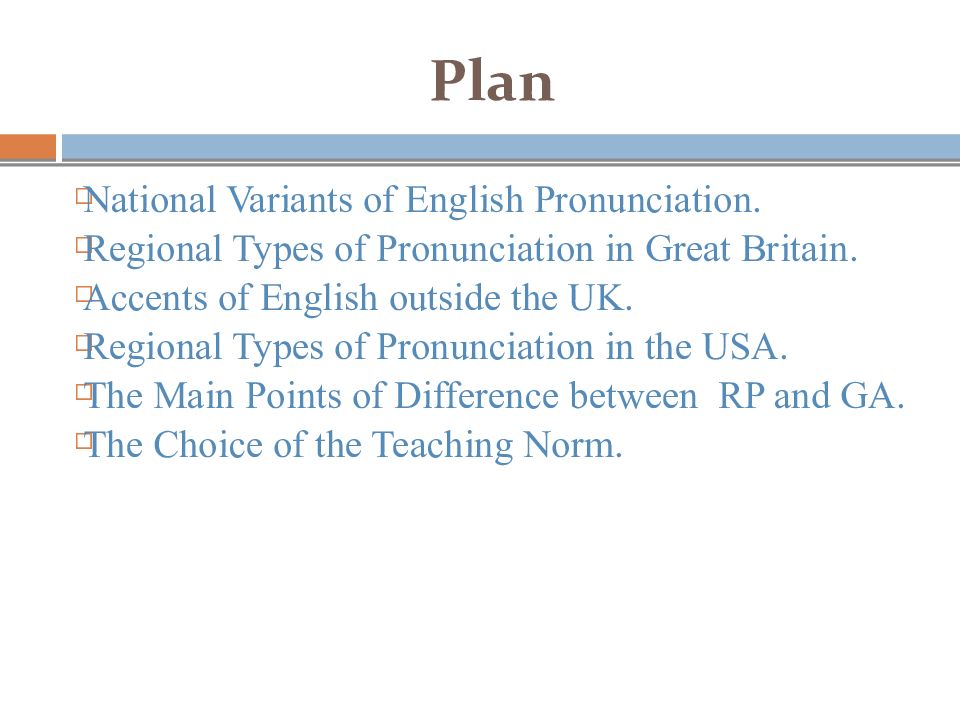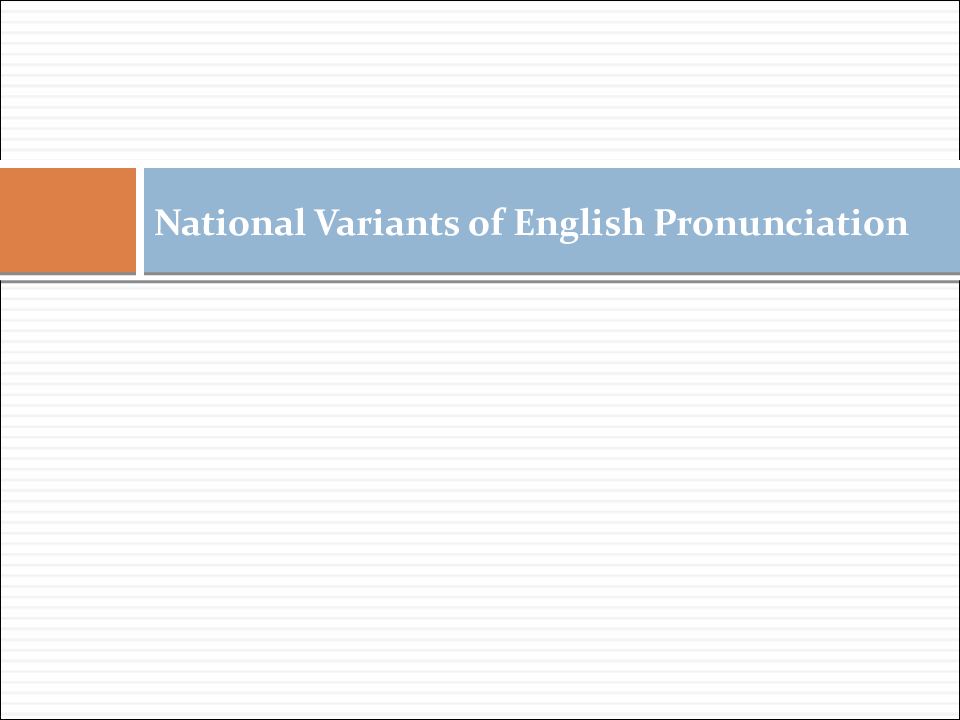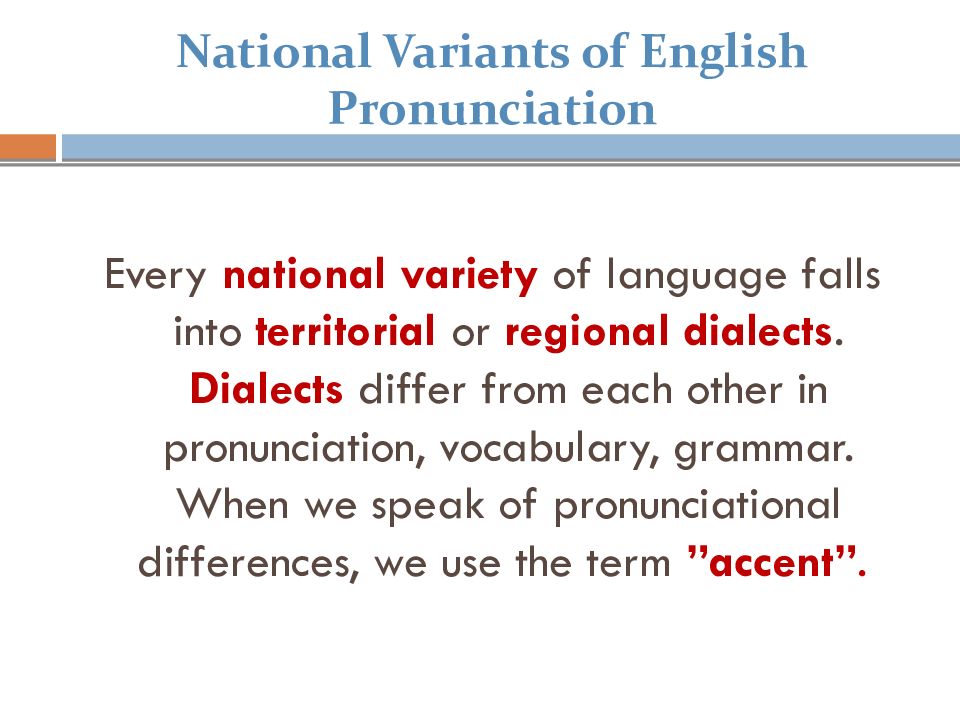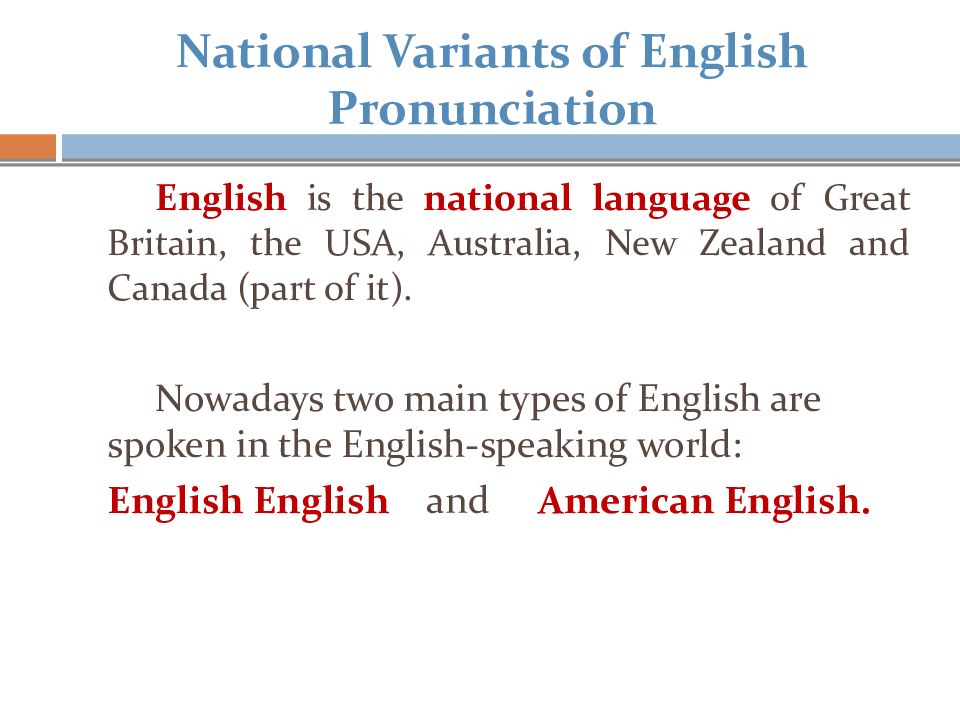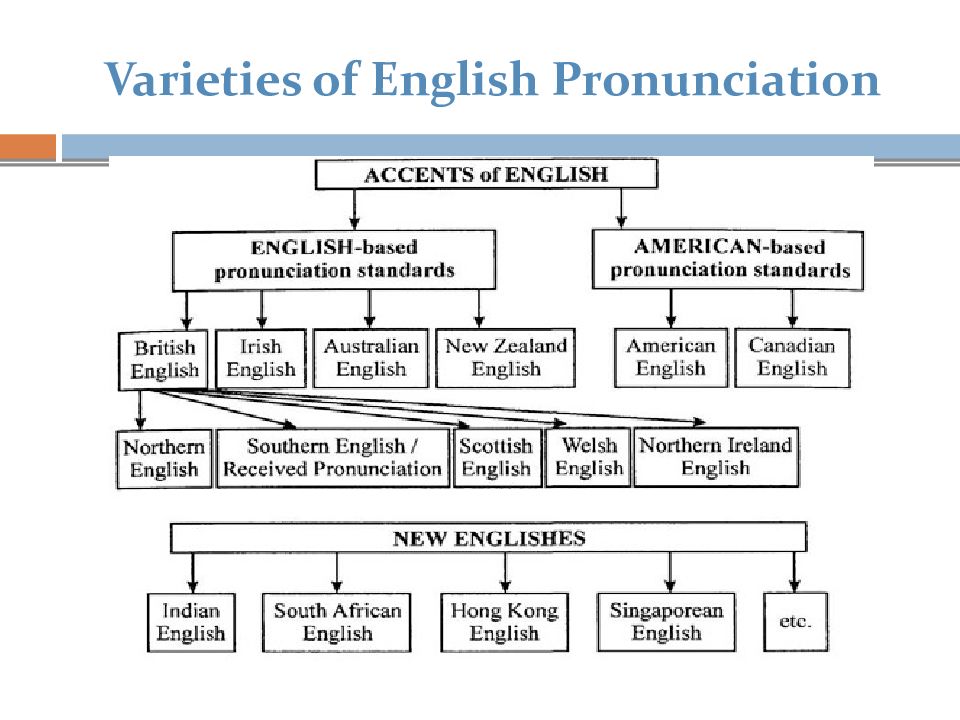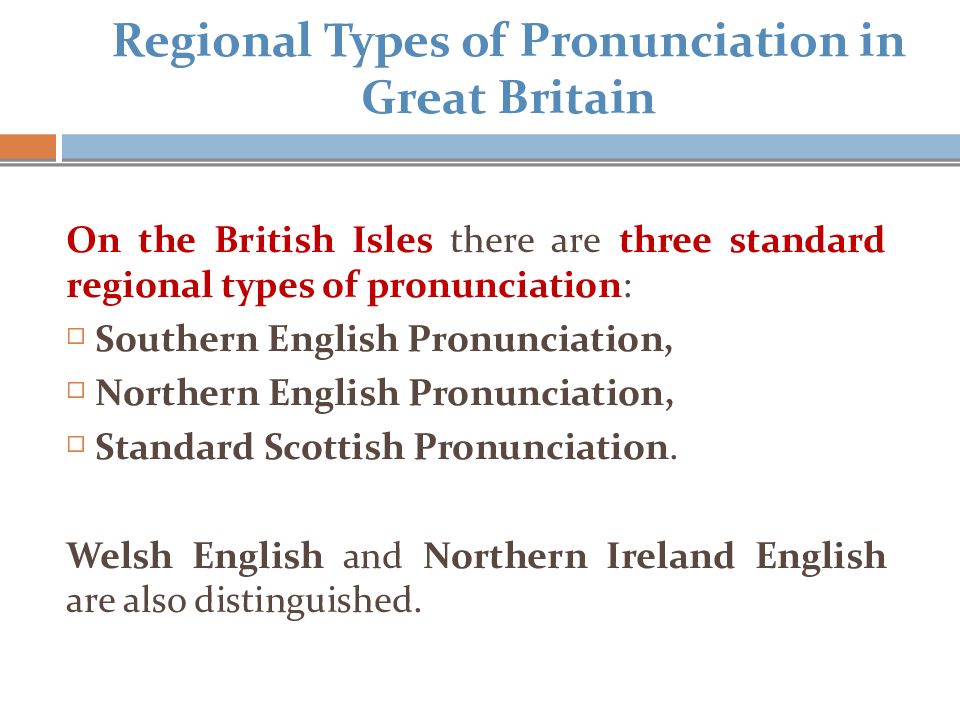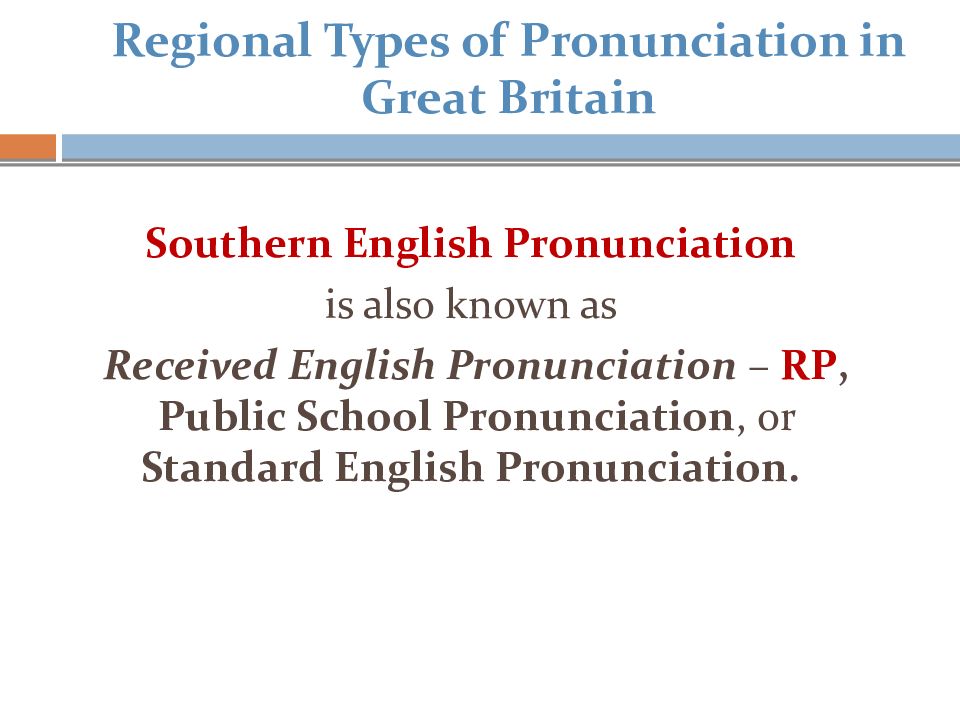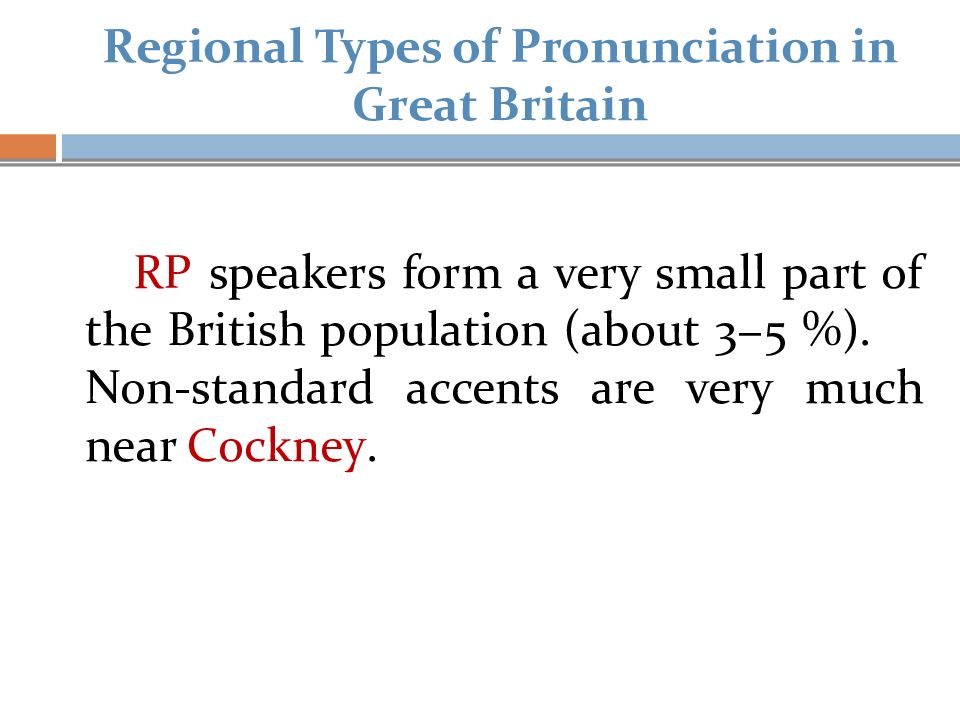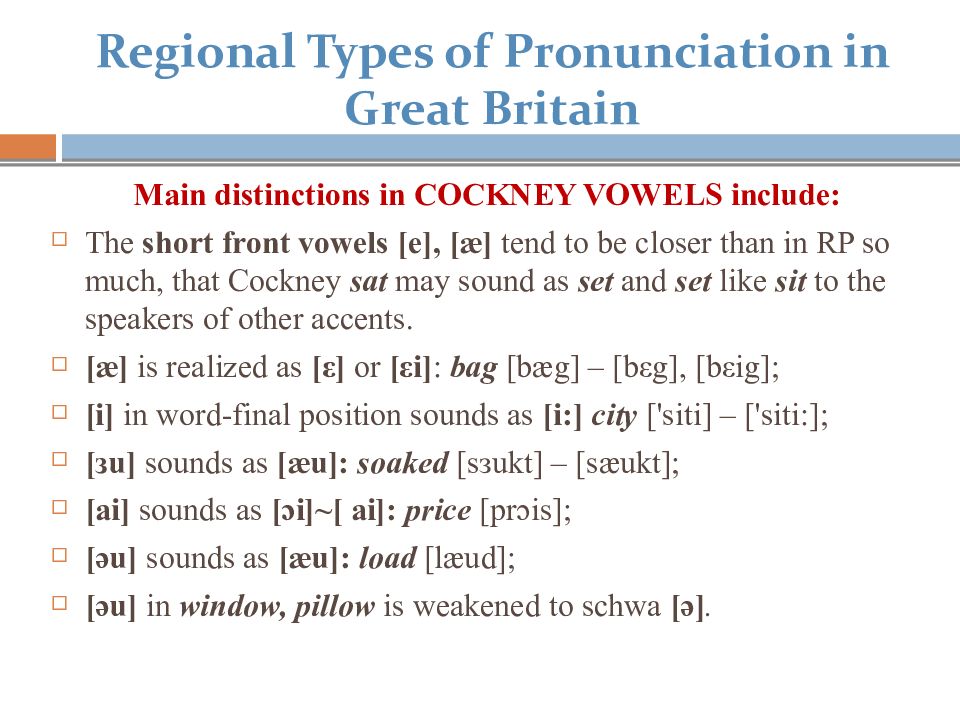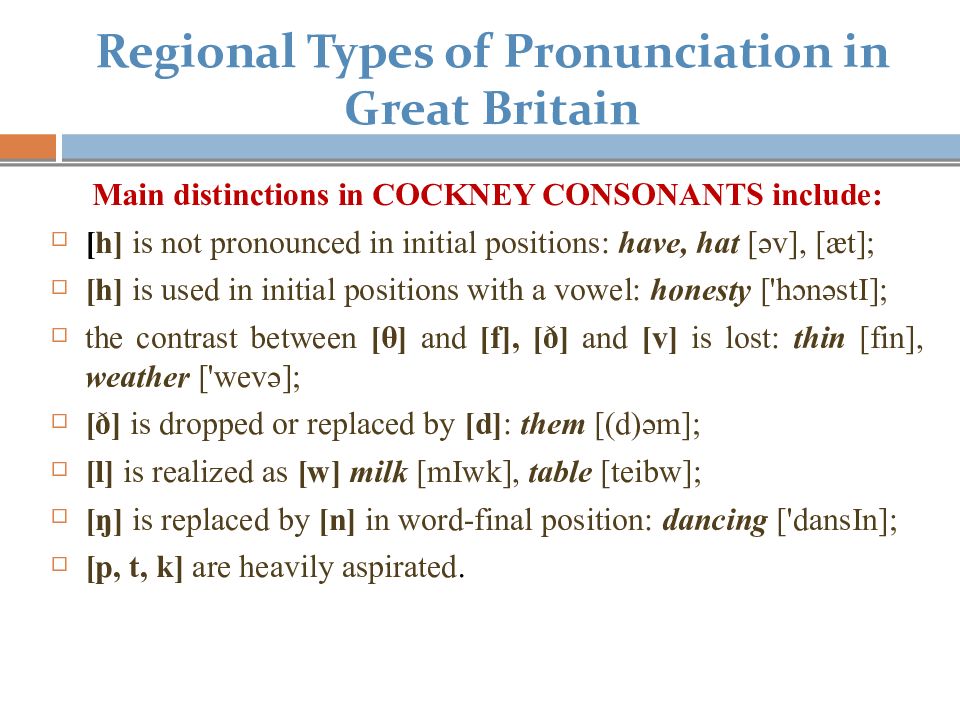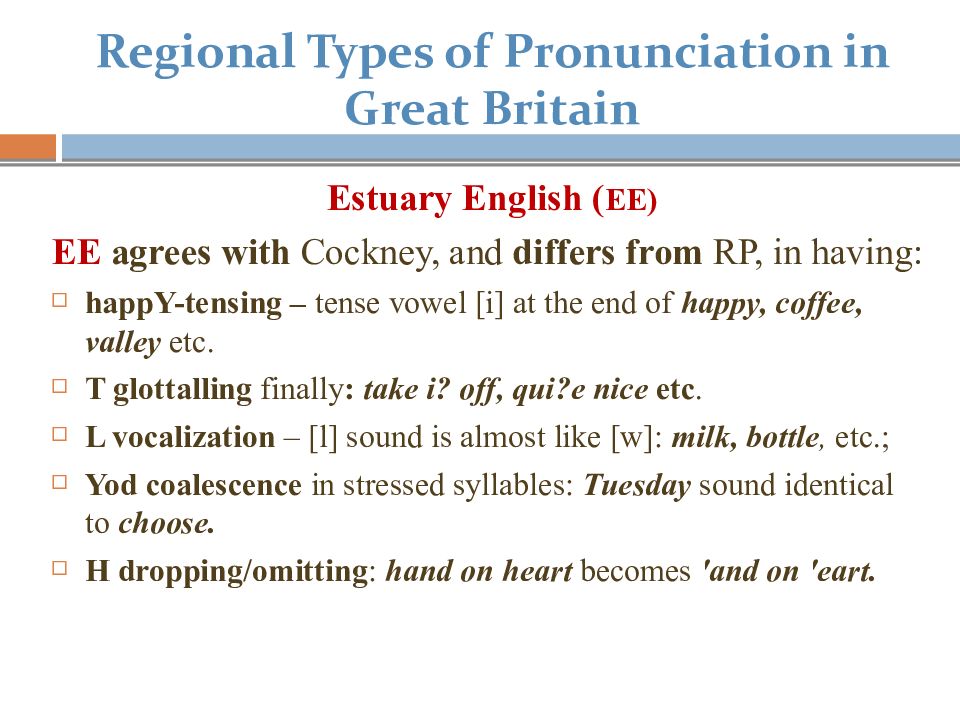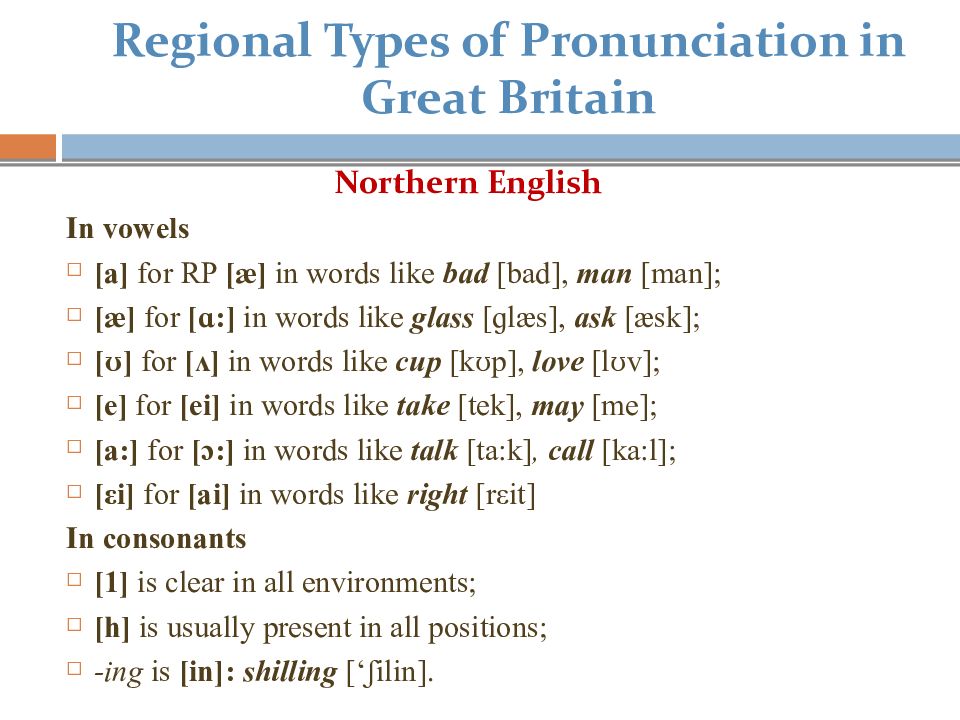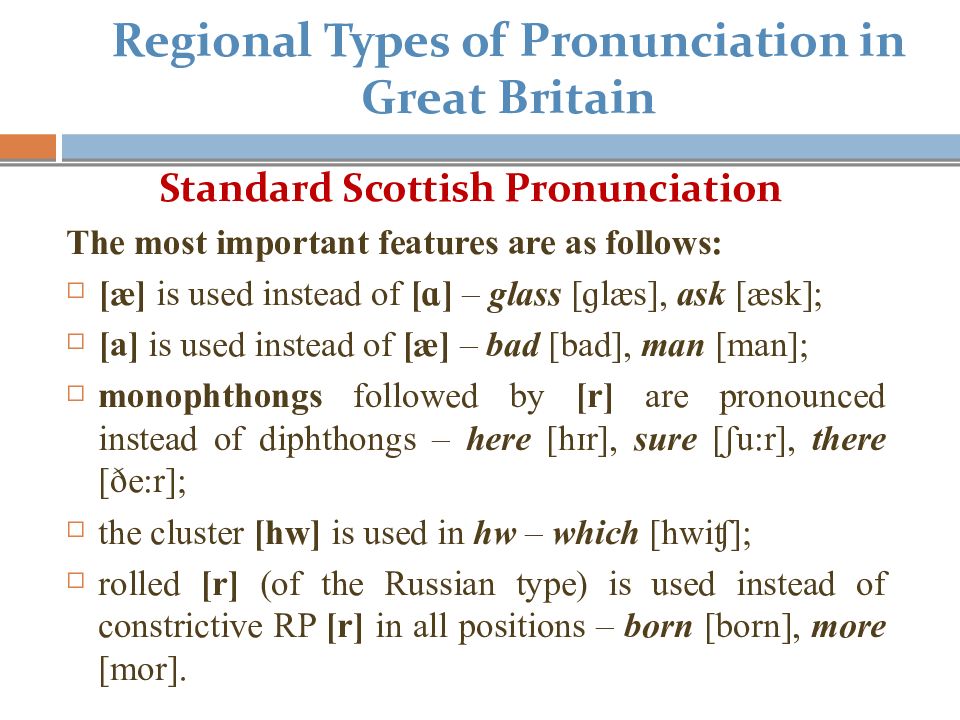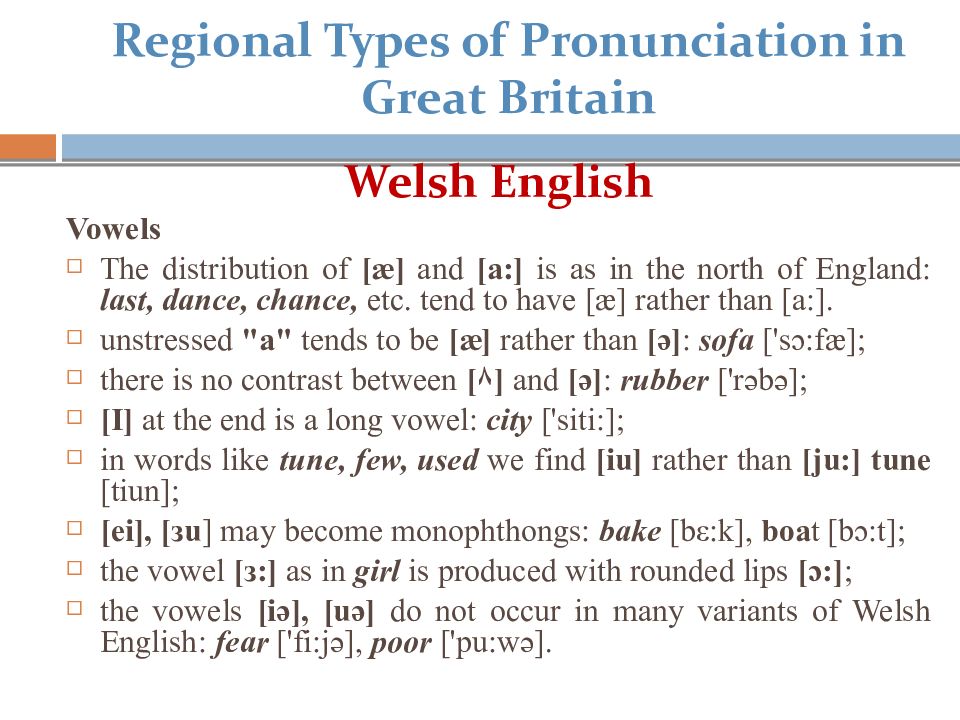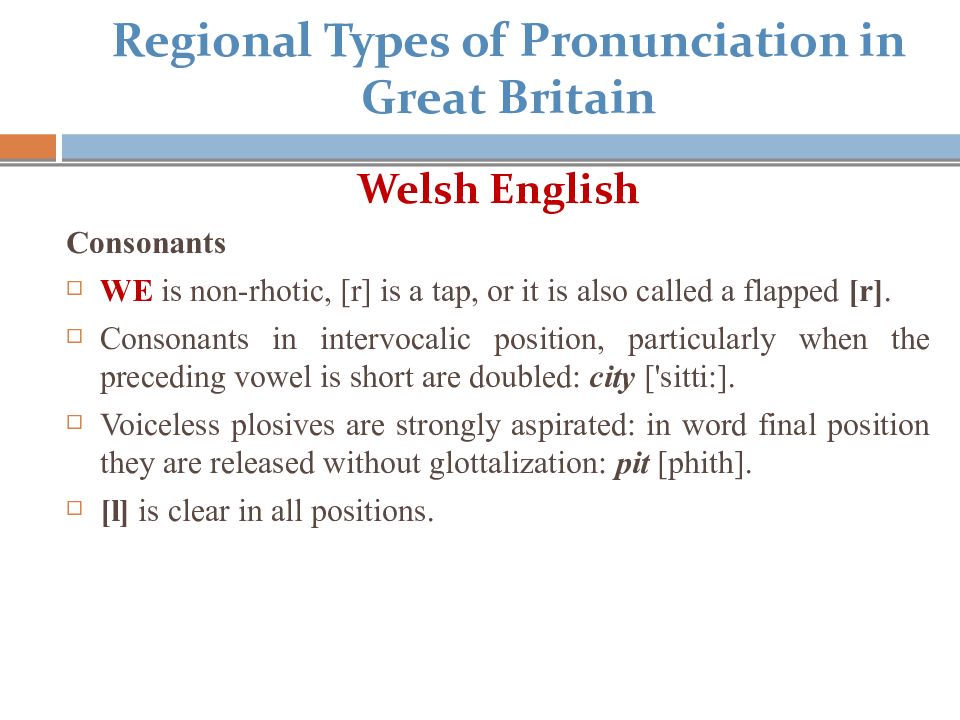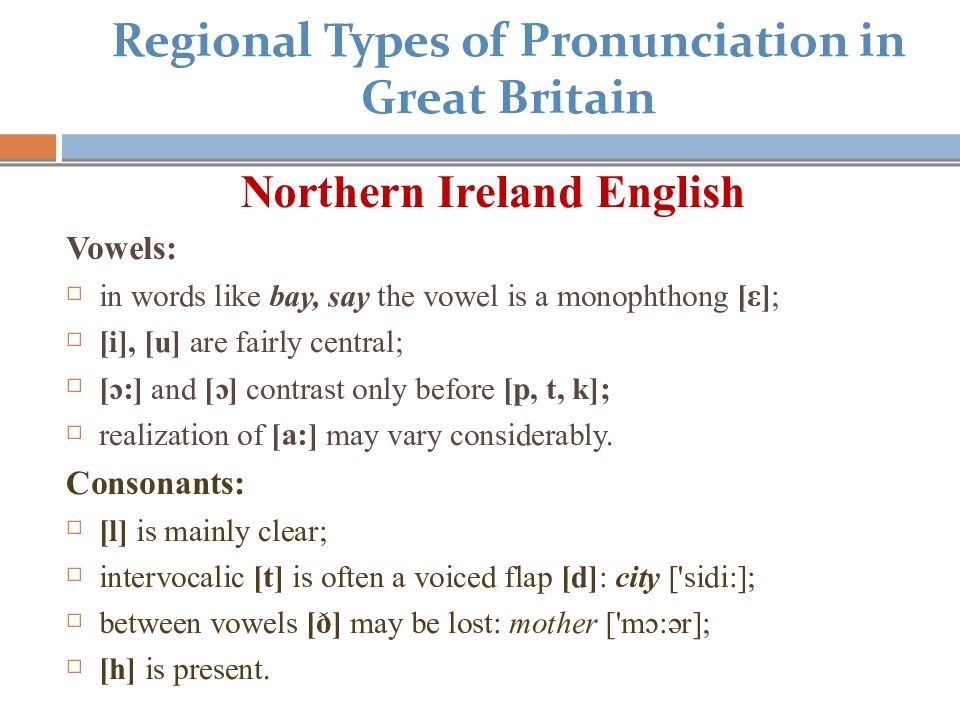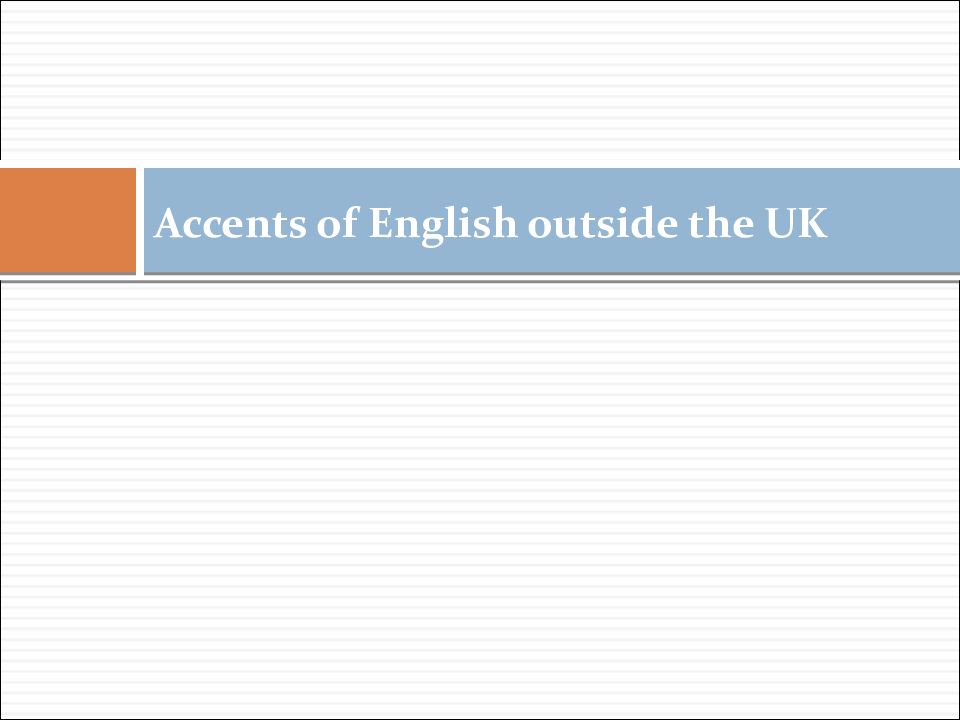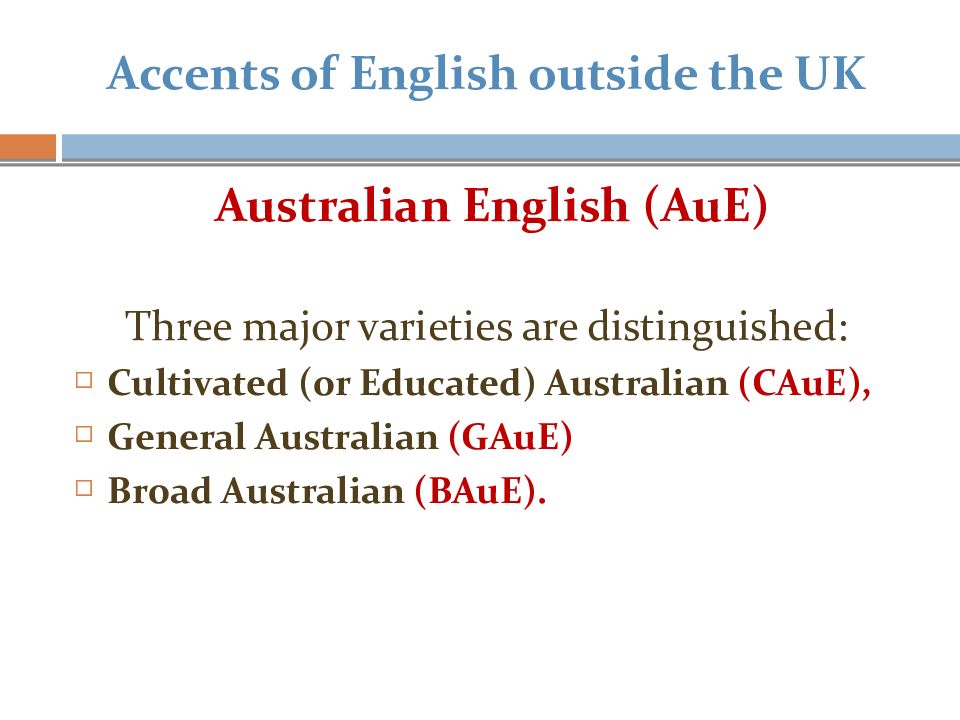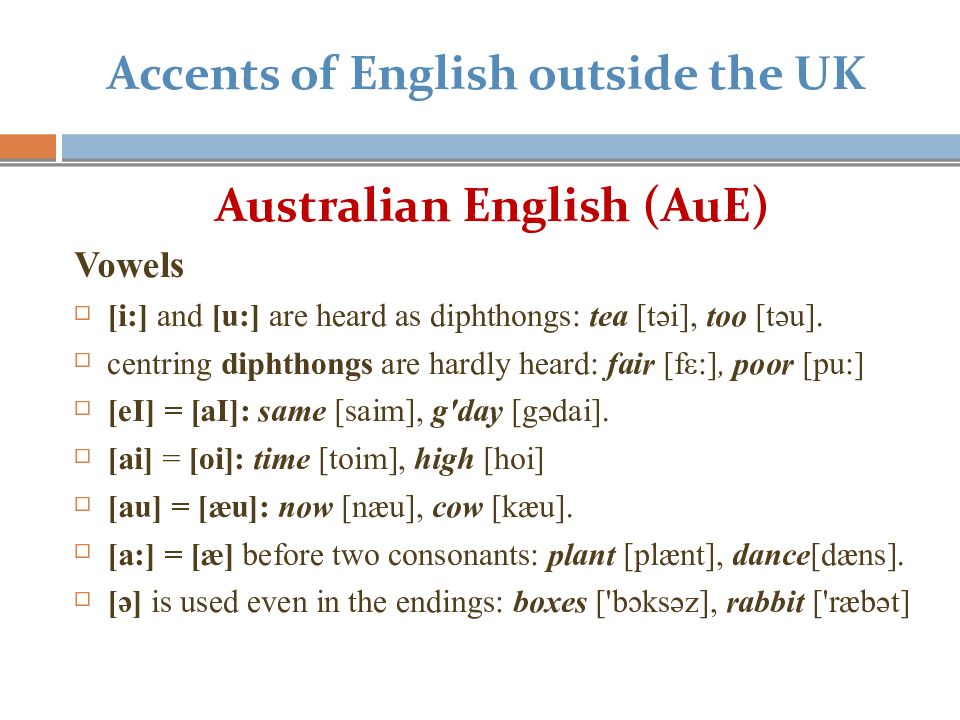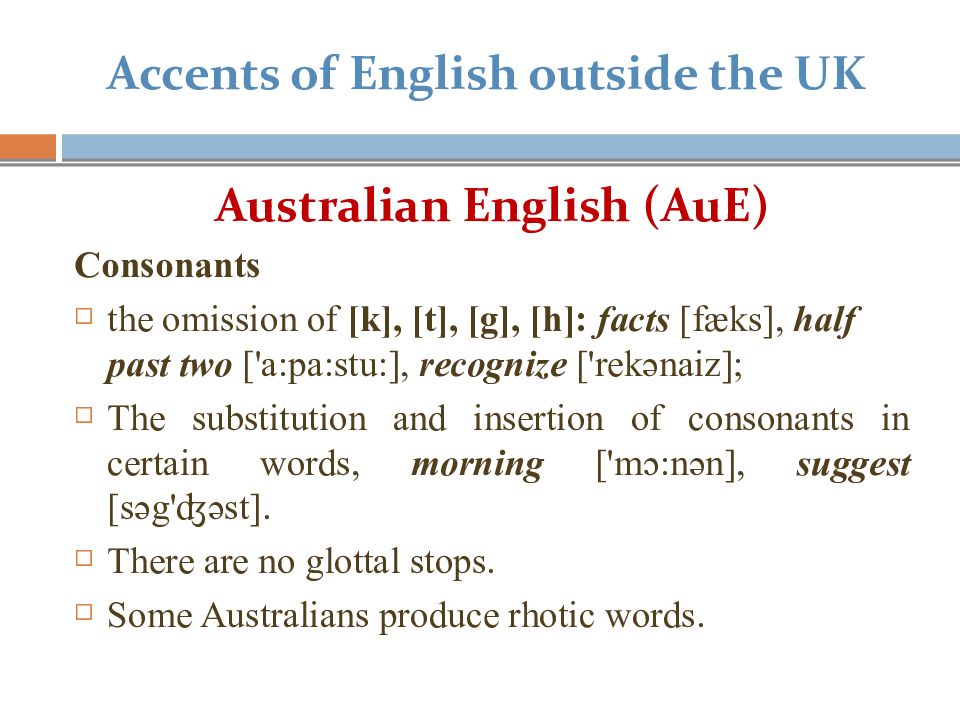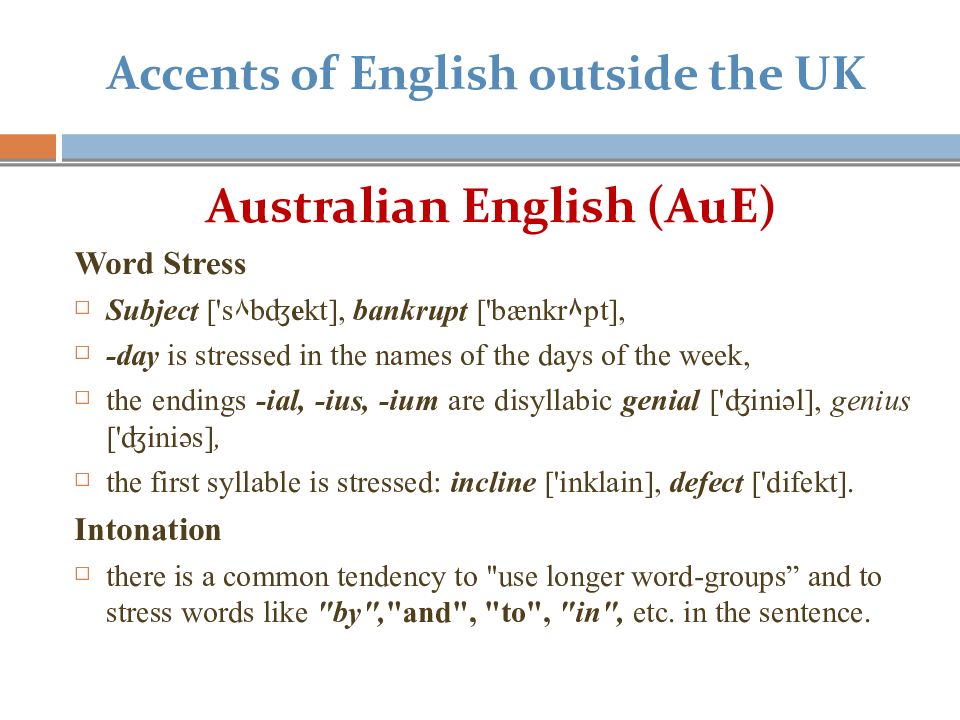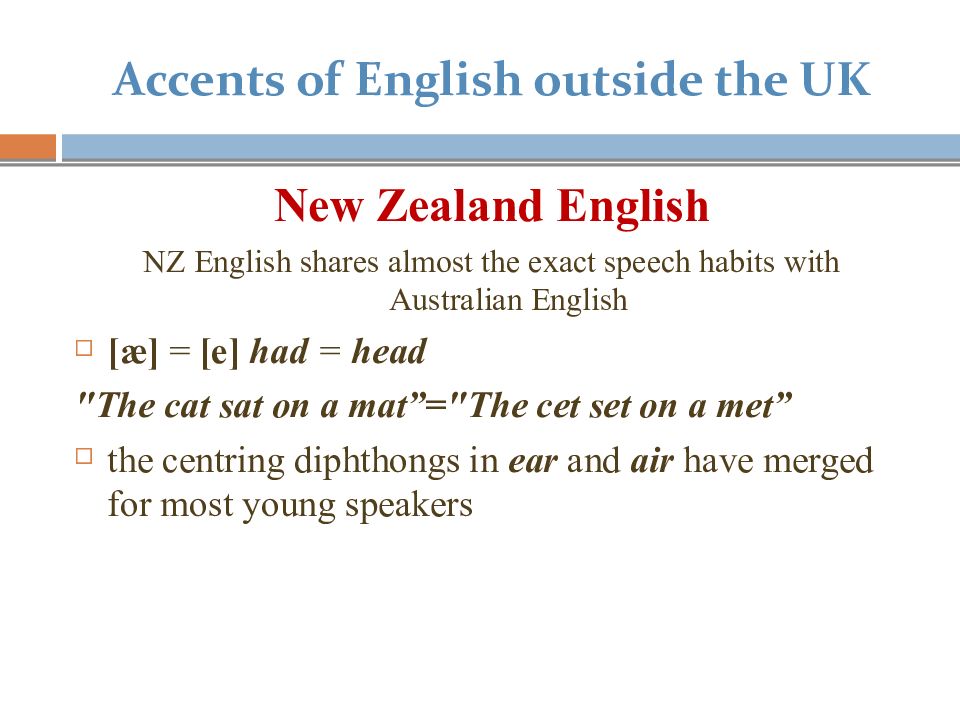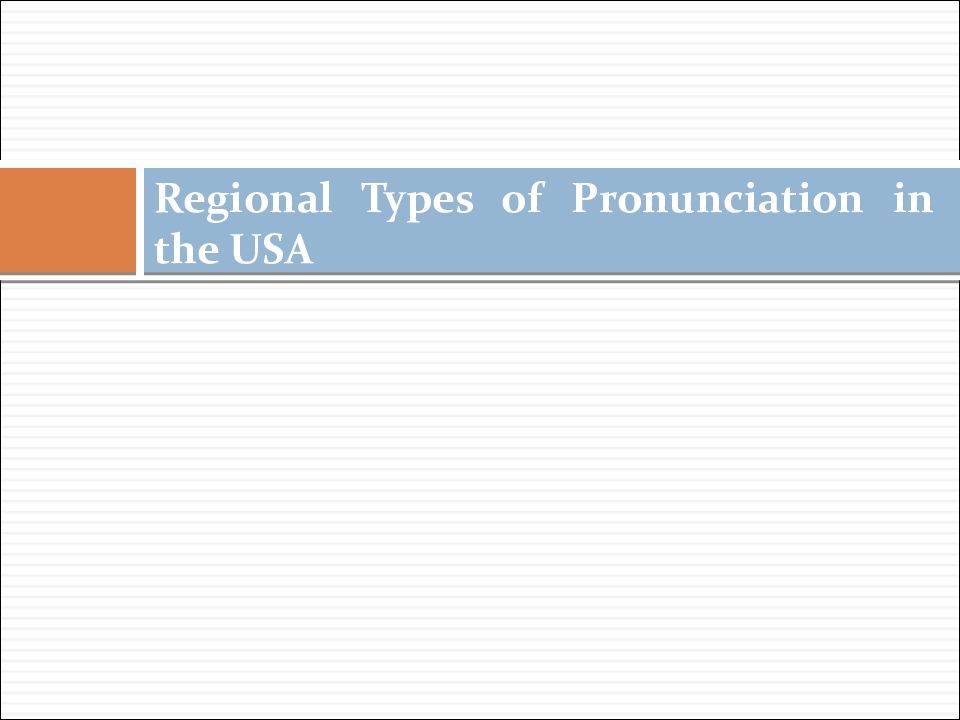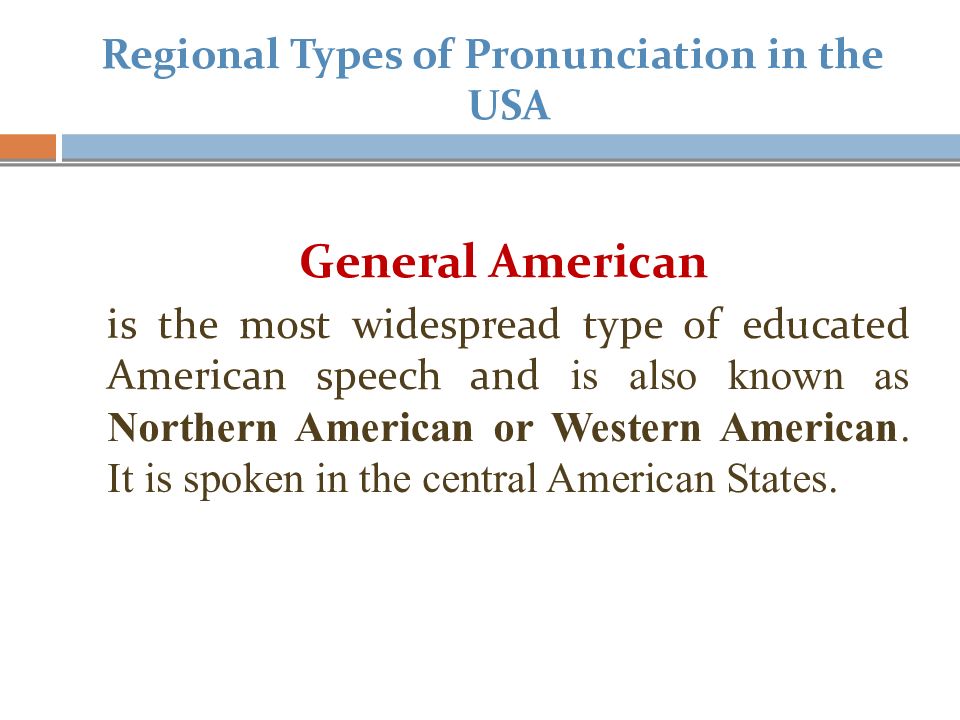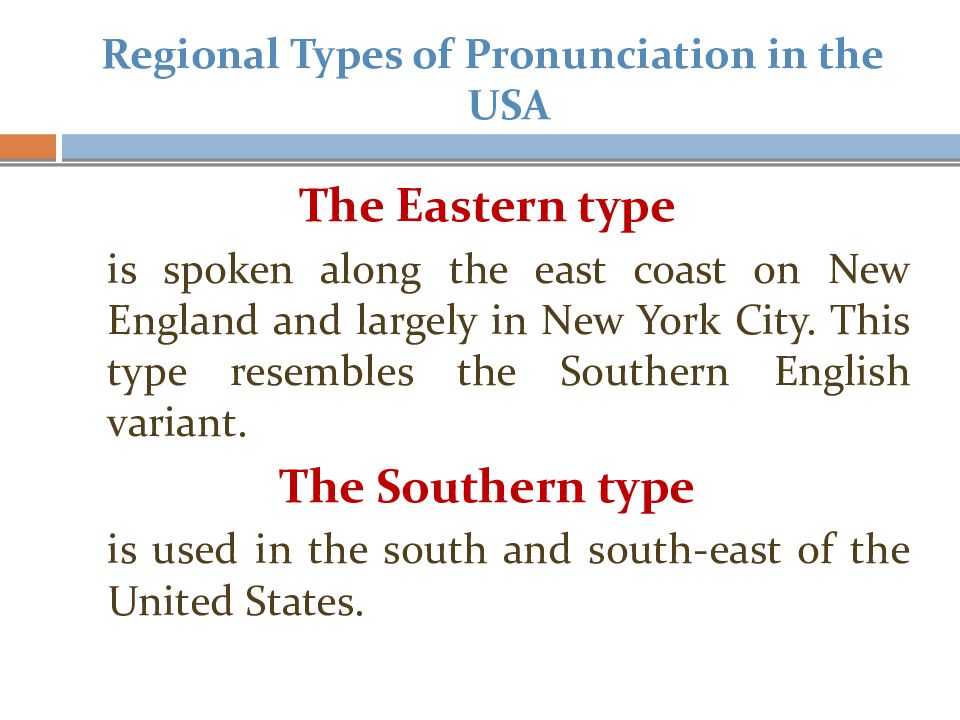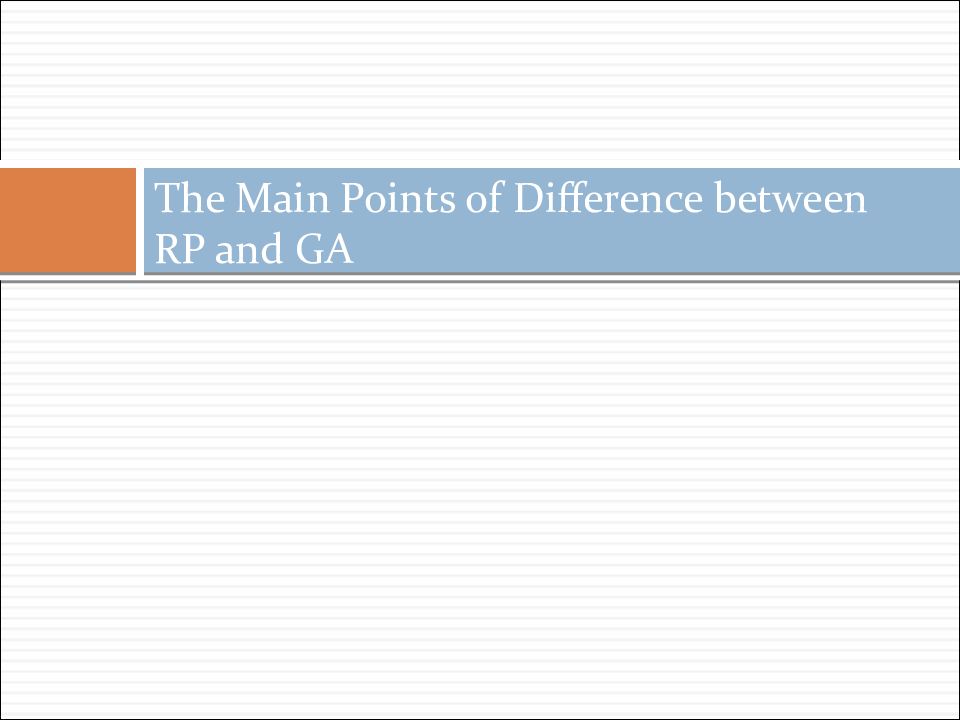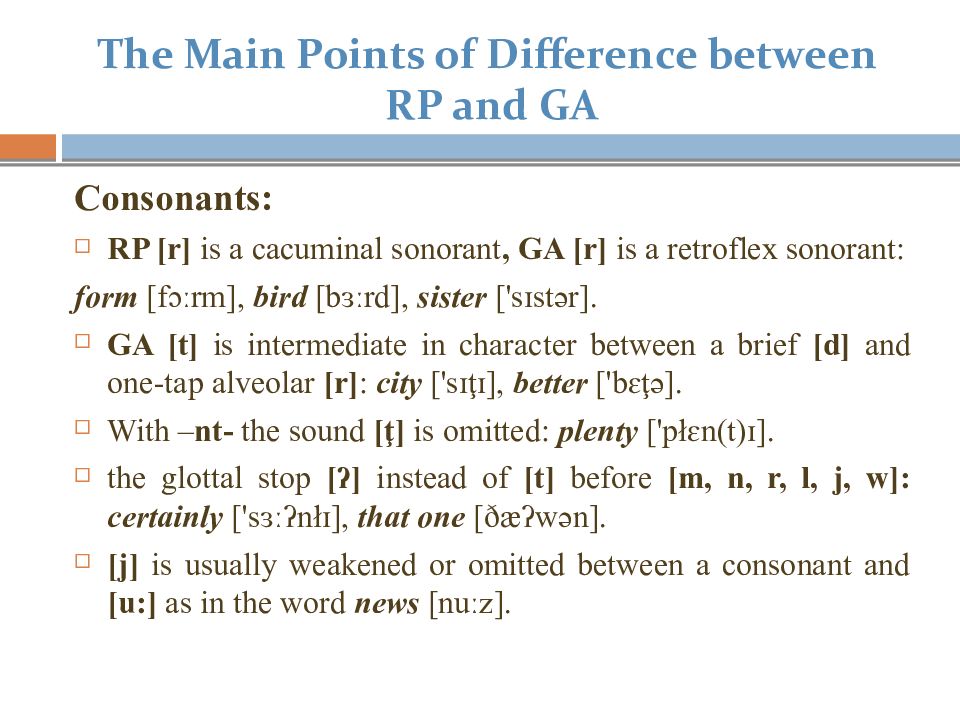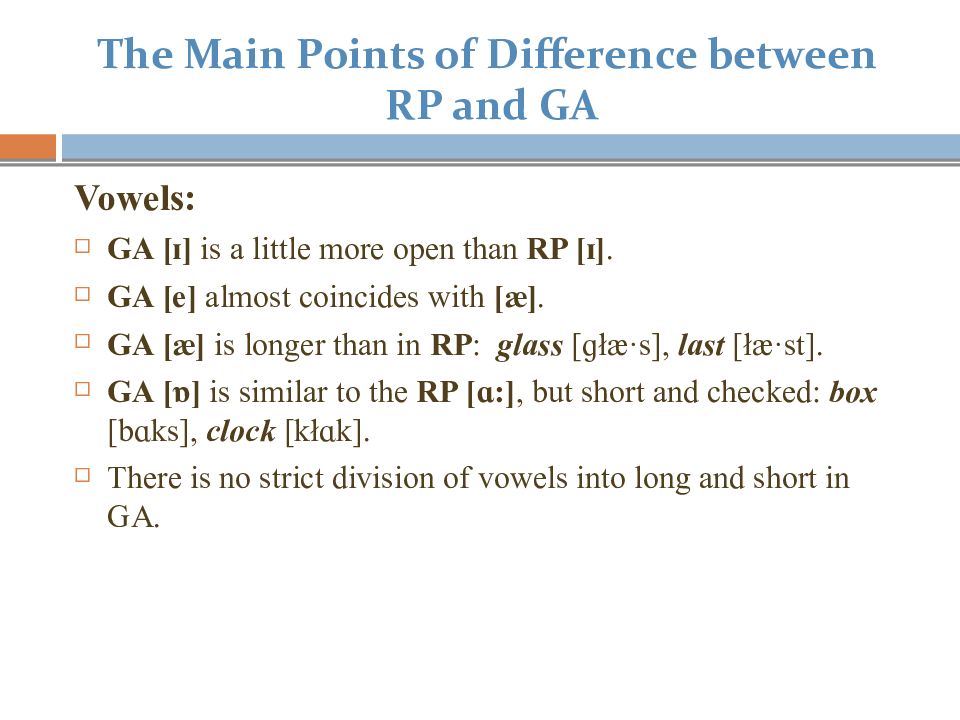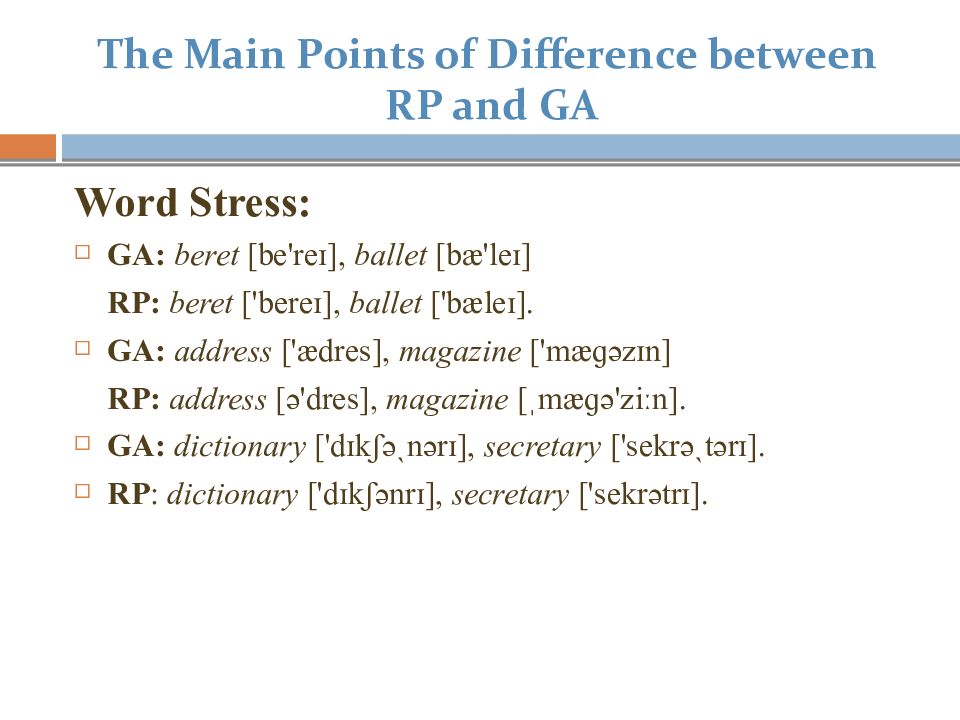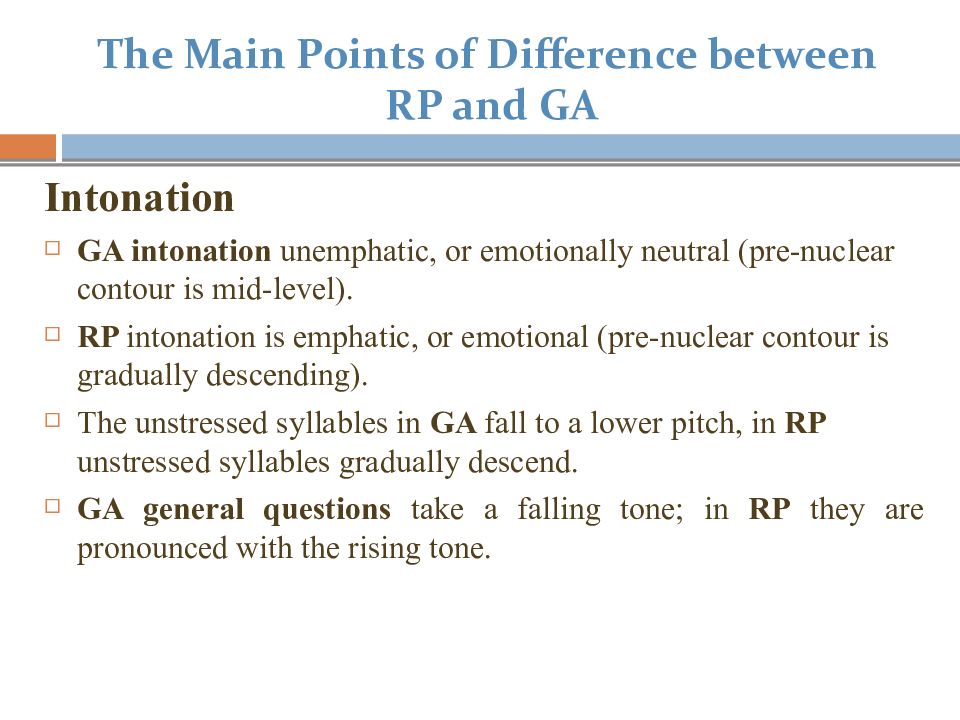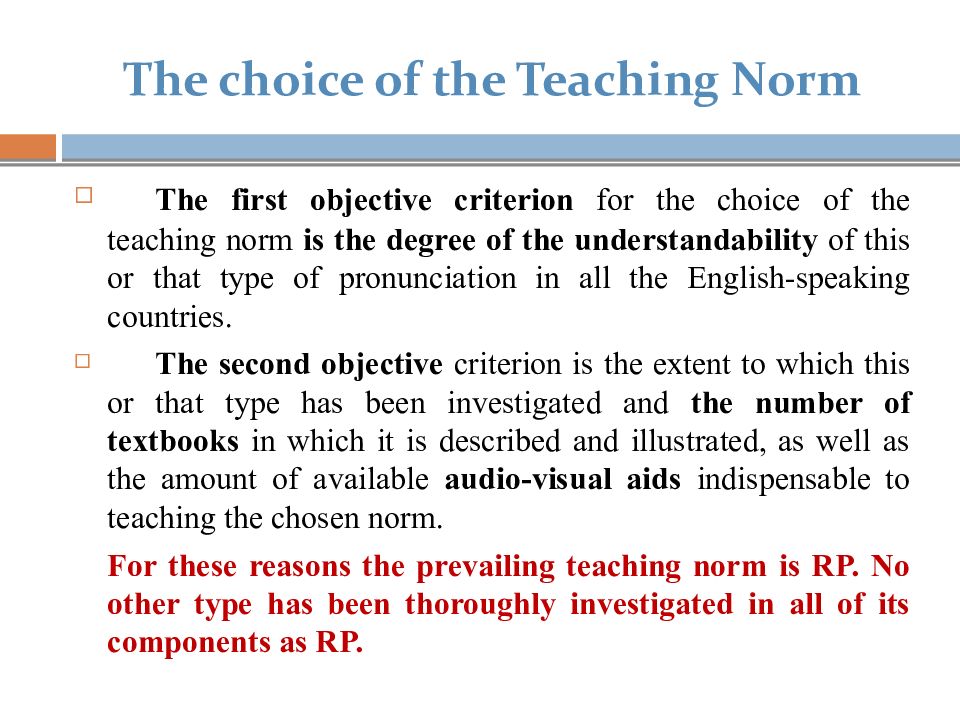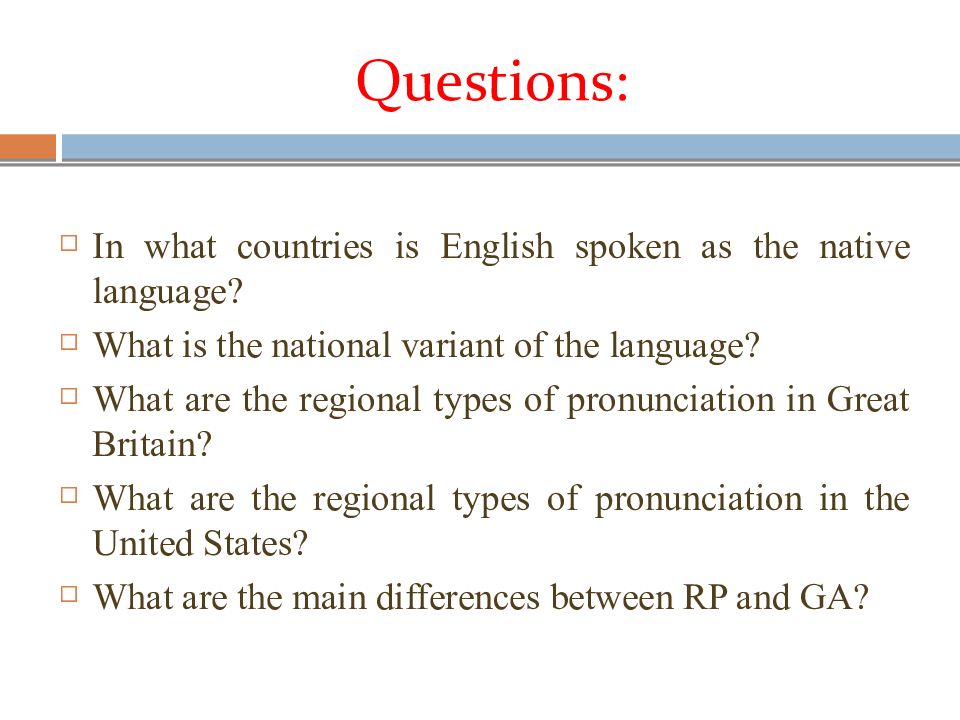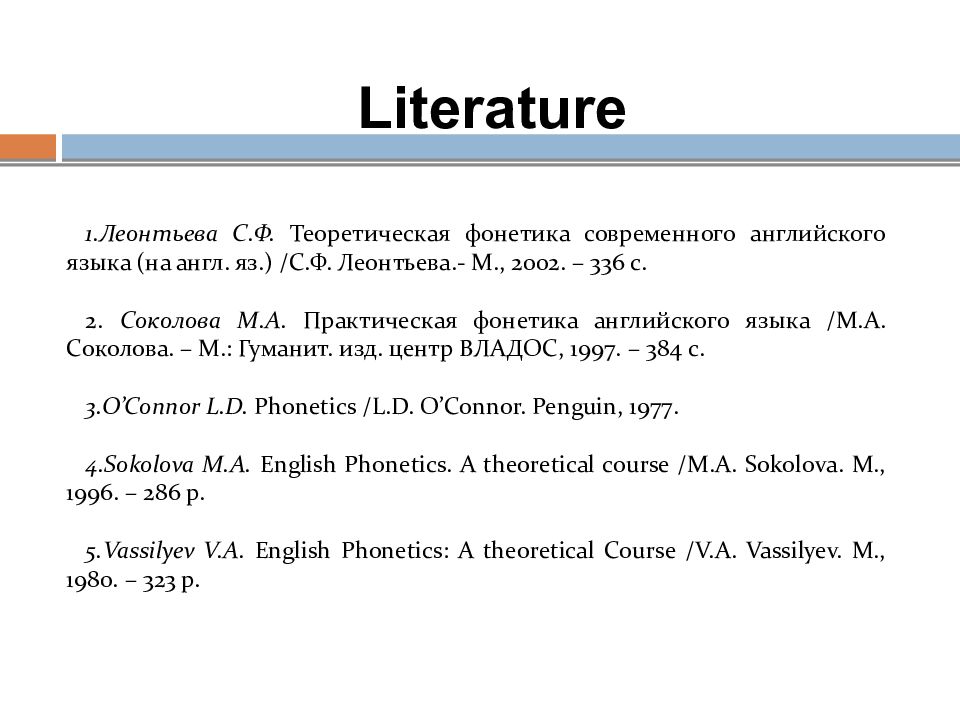Первый слайд презентации: TERritorial varieties of english prounciation
Lecture 7
Слайд 2: Plan
National Variants of English Pronunciation. Regional Types of Pronunciation in Great Britain. Accents of English outside the UK. Regional Types of Pronunciation in the USA. The Main Points of Difference between RP and GA. The Choice of the Teaching Norm.
Every national variety of language falls into territorial or regional dialects. Dialects differ from each other in pronunciation, vocabulary, grammar. When we speak of pronunciational differences, we use the term ”accent”.
English is the national language of Great Britain, the USA, Australia, New Zealand and Canada (part of it). Nowadays two main types of English are spoken in the English-speaking world: English English and American English.
Слайд 8: Regional Types of Pronunciation in Great Britain
On the British Isles there are three standard regional types of pronunciation : Southern English Pronunciation, Northern English Pronunciation, Standard Scottish Pronunciation. Welsh English and Northern Ireland English are also distinguished.
Слайд 9: Regional Types of Pronunciation in Great Britain
Southern English Pronunciation is also known as Received English Pronunciation – RP, Public School Pronunciation, or Standard English Pronunciation.
Слайд 10: Regional Types of Pronunciation in Great Britain
RP speakers form a very small part of the British population (about 3−5 %). Non-standard accents are very much near Cockney.
Слайд 11: Regional Types of Pronunciation in Great Britain
Main distinctions in COCKNEY VOWELS include: The short front vowels [e], [æ] tend to be closer than in RP so much, that Cockney sat may sound as set and set like sit to the speakers of other accents. [æ] is realized as [ ε ] or [ ε i] : bag [bæg] – [b ε g], [b ε ig]; [i] in word-final position sounds as [i:] city ['siti] – ['siti:]; [ з u] sounds as [æu]: soaked [s з ukt] – [sæukt]; [ai] sounds as [ɔi]~[ ai]: price [prɔis]; [əu] sounds as [æu]: load [læud]; [əu] in window, pillow is weakened to schwa [ə].
Слайд 12: Regional Types of Pronunciation in Great Britain
Main distinctions in COCKNEY CONSONANTS include: [ h] is not pronounced in initial positions: have, hat [ əv ], [ æt ]; [h] is used in initial positions with a vowel: honesty [' hɔnəstI ]; the contrast between [ θ ] and [f], [ð] and [v] is lost: thin [fin], weather [' wevə ]; [ð] is dropped or replaced by [d] : them [(d) əm ]; [l] is realized as [w] milk [ mIwk ], table [ teibw ]; [ŋ] is replaced by [n] in word-final position: dancing [' dansIn ]; [p, t, k] are heavily aspirated.
Слайд 13: Regional Types of Pronunciation in Great Britain
Estuary English ( EE) EE agrees with Cockney, and differs from RP, in having: happY -tensing – tense vowel [ і ] at the end of happy, coffee, valley etc. T glottalling finally : take i ? off, qui?e nice etc. L vocalization – [l] sound is almost like [w]: milk, bottle, etc.; Yod coalescence in stressed syllables: Tuesday sound identical to choose. H dropping/omitting : hand on heart becomes 'and on ' eart.
Слайд 14: Regional Types of Pronunciation in Great Britain
Northern English In vowels [a] for RP [æ] in words like bad [bad], man [man]; [æ] for [ɑ:] in words like glass [ ɡlæs ], ask [ æsk ]; [ʊ] for [ʌ] in words like cup [ kʊp ], love [ lʊv ]; [e] for [ ei ] in words like take [ tek ], may [me]; [a:] for [ɔ:] in words like talk [ ta:k ], call [ ka:l ]; [ ε i ] for [ ai ] in words like right [r ε it] In consonants [1] is clear in all environments; [h] is usually present in all positions; - ing is [in]: shilling [‘ ʃilin ].
Слайд 15: Regional Types of Pronunciation in Great Britain
Standard Scottish Pronunciation The most important features are as follows: [æ] is used instead of [ɑ] – glass [ ɡlæs ], ask [ æsk ]; [a] is used instead of [æ] – bad [bad], man [man]; monophthongs followed by [r] are pronounced instead of diphthongs – here [ hɪr ], sure [ ʃu:r ], there [ ðe:r ]; the cluster [hw] is used in hw – which [ hwiʧ ]; rolled [r] (of the Russian type) is used instead of constrictive RP [r] in all positions – born [born], more [ mor ].
Слайд 16: Regional Types of Pronunciation in Great Britain
Welsh English Vowels The distribution of [æ] and [a:] is as in the north of England: last, dance, chance, etc. tend to have [æ] rather than [a:]. unstressed "a" tends to be [æ] rather than [ə] : sofa ['sɔ:fæ]; there is no contrast between [ ٨ ] and [ə] : rubber ['rəbə]; [I] at the end is a long vowel: city ['siti:]; in words like tune, few, used we find [iu] rather than [ju:] tune [tiun]; [ei], [ з u ] may become monophthongs: bake [b ε :k], boa t [bɔ:t]; the vowel [ з :] as in girl is produced with rounded lips [ɔ:] ; the vowels [iə], [uə] do not occur in many variants of Welsh English: fear ['fi:jə], poor ['pu:wə].
Слайд 17: Regional Types of Pronunciation in Great Britain
Welsh English Consonants WE is non- rhotic, [r] is a tap, or it is also called a flapped [r]. Consonants in intervocalic position, particularly when the preceding vowel is short are doubled: city [' sitti :]. Voiceless plosives are strongly aspirated: in word final position they are released without glottalization : pit [ phith ]. [l] is clear in all positions.
Слайд 18: Regional Types of Pronunciation in Great Britain
Northern Ireland English Vowels: in words like bay, say the vowel is a monophthong [ ε ] ; [ i ], [u] are fairly central; [ɔ:] and [ɔ] contrast only before [p, t, k]; realization of [a:] may vary considerably. Consonants: [l] is mainly clear; intervocalic [t] is often a voiced flap [d] : city [' sidi :]; between vowels [ð] may be lost: mother [' mɔ:ər ]; [h] is present.
Слайд 20: Accents of English outside the UK
Australian English ( AuE ) Three major varieties are distinguished: Cultivated (or Educated) Australian ( CAuE ), General Australian ( GAuE ) Broad Australian ( BAuE ).
Слайд 21: Accents of English outside the UK
Australian English ( AuE ) Vowels [ i :] and [u:] are heard as diphthongs: tea [ təi ], too [ təu ]. centring diphthongs are hardly heard: fair [f ε :], poor [ pu :] [ е I] = [ aI ]: same [ saim ], g'day [ gədai ]. [ ai ] = [ oi ]: time [ toim ], high [hoi] [au] = [ æu ]: now [ næu ], cow [ kæu ]. [a:] = [æ] before two consonants: plant [ plænt ], dance [ dæns ]. [ə] is used even in the endings: boxes [' bɔksəz ], rabbit [' ræbət ]
Слайд 22: Accents of English outside the UK
Australian English ( AuE ) Consonants the omission of [k], [t], [g], [h]: facts [ fæks ], half past two ['a:pa:stu:], recognize [' rekənaiz ]; The substitution and insertion of consonants in certain words, morning [' mɔ:nən ], suggest [ səg'ʤəst ]. There are no glottal stops. Some Australians produce rhotic words.
Слайд 23: Accents of English outside the UK
Australian English ( AuE ) Word Stress Subject ['s ٨ bʤ e kt ], bankrupt [' bænkr ٨ pt], -day is stressed in the names of the days of the week, the endings - ial, - ius, - ium are disyllabic genial [' ʤiniəl ], genius [' ʤiniəs ], the first syllable is stressed: incline [' inklain ], defect [' difekt ]. Intonation there is a common tendency to "use longer word-groups” and to stress words like " by", "and ", "to", "in", etc. in the sentence.
Слайд 24: Accents of English outside the UK
Canadian English ( CnE ) [ ai ] = [ əi ] and [au] =[ ٨ u ]: price, like, mouth, south; [ е ]-[æ]-[ ε ə] = [ ε ] in merry – marry – Mary; [ ٨ ] = [ з r] hurry, courage, current, worry flapping of the alveolar sounds [t], [d] waiting, writer, rider.
Слайд 25: Accents of English outside the UK
New Zealand English NZ English shares almost the exact speech habits with Australian English [æ] = [e] had = head "The cat sat on a mat”="The cet set on a met” the centring diphthongs in ear and air have merged for most young speakers
Слайд 27: Regional Types of Pronunciation in the USA
In the United States there may be distinguished: the General American type (GA), the Eastern type, the Southern type.
Слайд 28: Regional Types of Pronunciation in the USA
General American is the most widespread type of educated American speech and is also known as Northern American or Western American. It is spoken in the central American States.
Слайд 29: Regional Types of Pronunciation in the USA
The Eastern type is spoken along the east coast on New England and largely in New York City. This type resembles the Southern English variant. The Southern type is used in the south and south-east of the United States.
Слайд 31: The Main Points of Difference between RP and GA
Since RP and GA are the most widely accepted types of pronunciation the learners of English should know the principal differences between them.
Слайд 32: The Main Points of Difference between RP and GA
Consonants: RP [r] is a cacuminal sonorant, GA [r] is a retroflex sonorant: form [ fɔːrm ], bird [ bɜːrd ], sister [' sɪstər ]. GA [t] is intermediate in character between a brief [d] and one-tap alveolar [r] : city [' sɪţɪ ], better [' bɛţə ]. With – nt - the sound [ţ] is omitted: plenty [' płɛn (t)ɪ]. the glottal stop [ʔ] instead of [t] before [m, n, r, l, j, w]: certainly [' sɜːʔnłɪ ], that one [ ðæʔwən ]. [j] is usually weakened or omitted between a consonant and [u:] as in the word news [ nuːz ].
Слайд 33: The Main Points of Difference between RP and GA
Vowels: GA [ɪ] is a little more open than RP [ɪ]. GA [e] almost coincides with [æ]. GA [æ] is longer than in RP : glass [ ɡłæ·s ], last [ łæ·st ]. GA [ɒ] is similar to the RP [ɑ:], but short and checked: box [ bɑks ], clock [ kłɑk ]. There is no strict division of vowels into long and short in GA.
Слайд 34: The Main Points of Difference between RP and GA
Word Stress: GA: beret [ be'reɪ ], ballet [ bæ'leɪ ] RP: beret [' bereɪ ], ballet [' bæleɪ ]. GA: address [' ædres ], magazine [' mæɡəzɪn ] RP: address [ ə'dres ], magazine [ˌ mæɡə'ziːn ]. GA: dictionary [' dɪkʃəˎnərɪ ], secretary [' sekrəˎtərɪ ]. RP : dictionary [' dɪkʃənrɪ ], secretary [' sekrətrɪ ].
Слайд 35: The Main Points of Difference between RP and GA
Intonation GA intonation unemphatic, or emotionally neutral (pre-nuclear contour is mid-level). RP intonation is emphatic, or emotional (pre-nuclear contour is gradually descending). The unstressed syllables in GA fall to a lower pitch, in RP unstressed syllables gradually descend. GA general questions take a falling tone; in RP they are pronounced with the rising tone.
Слайд 37: The choice of the Teaching Norm
The first objective criterion for the choice of the teaching norm is the degree of the understandability of this or that type of pronunciation in all the English-speaking countries. The second objective criterion is the extent to which this or that type has been investigated and the number of textbooks in which it is described and illustrated, as well as the amount of available audio-visual aids indispensable to teaching the chosen norm. For these reasons the prevailing teaching norm is RP. No other type has been thoroughly investigated in all of its components as RP.
Слайд 38: Questions:
In what countries is English spoken as the native language? What is the national variant of the language? What are the regional types of pronunciation in Great Britain? What are the regional types of pronunciation in the United States? What are the main differences between RP and GA?
Слайд 39: Literature
Леонтьева С.Ф. Теоретическая фонетика современного английского языка (на англ. яз.) /С.Ф. Леонтьева.- М., 2002. – 336 с. Соколова М.А. Практическая фонетика английского языка /М.А. Соколова. – М.: Гуманит. изд. центр ВЛАДОС, 1997. – 384 с. O’Connor L.D. Phonetics /L.D. O’Connor. Penguin, 1977. Sokolova M.A. English Phonetics. A theoretical course /M.A. Sokolova. M., 1996. – 286 p. Vassilyev V.A. English Phonetics: A theoretical Course /V.A. Vassilyev. M., 1980. – 323 p.

